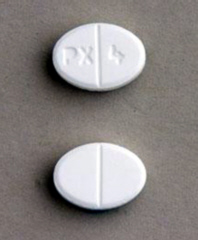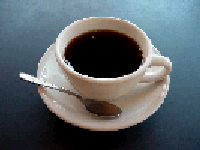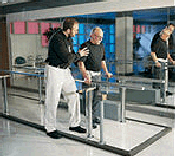|
JULY 2013
������������������ ������������������������������������������������������������������������������������������������������������������������������
29th July 2013 - New research
PRAMIPEXOLE : EXTENDED RELEASE v IMMEDIATE RELEASE
Drug Research [2013] Jul 24 [Epub ahead of print] (M.Takanashi, Y.Shimo,
T.Hatano, G.Oyama, N.Hattori)
Complete abstract
Changing from Immediate release Pramipexole to Extended release Pramipexole
was found to cause a reduction in Parkinson's Disease symptoms. Pramipexole,
which is marketed as� Mirapex, Mirapexin, and Sifrol, is a dopamine
agonist used in the treatment of Parkinson's Disease.
For more information go too
Mirapex and
MirapexER
 This
study aimed to evaluate the efficacy and safety of an extended-release
tablet formulation of pramipexole (PPX-ER) given once daily when switched
from an immediate-release tablet formulation (PPX-IR) given 3 times daily.
The extended release version evens out the effect of Pramipexole.
Parkinson's Disease symptom scores were reduced after 4 weeks and after 8
weeks. There was no change in the nocturnal and early morning symptoms
(NEMS) score, or the Parkinson's Disease Sleep Scale (PDSS-2). Nearly two
thirds of patients and caregivers preferred the extended release version.
For a printable version of this article
click here.
In order to refer to this article on its own
click here.����� This
study aimed to evaluate the efficacy and safety of an extended-release
tablet formulation of pramipexole (PPX-ER) given once daily when switched
from an immediate-release tablet formulation (PPX-IR) given 3 times daily.
The extended release version evens out the effect of Pramipexole.
Parkinson's Disease symptom scores were reduced after 4 weeks and after 8
weeks. There was no change in the nocturnal and early morning symptoms
(NEMS) score, or the Parkinson's Disease Sleep Scale (PDSS-2). Nearly two
thirds of patients and caregivers preferred the extended release version.
For a printable version of this article
click here.
In order to refer to this article on its own
click here.�����
�
26th July 2013 - New research
COFFEE REDUCES THE RISK OF PARKINSON'S DISEASE
Geriatrics and Gerontology International [2013] Jul 23 [Epub ahead of print]
(H.Qi, S.Li))
Complete abstract
��������������������������������������������������������������������������������������������������������������������������������������������������������������������������������� In the largest assessment of its kind coffee has been found to reduce the risk
of Parkinson's Disease as have tea and caffeine. With coffee the risk of
Parkinson's Disease was reduced to 72%.� The strength of this association
reached the maximum at approximately 3 cups per day.
 When
tea and caffeine were included in the assessment the risk of Parkinson's
Disease reduced in relation to the intake. The risk of Parkinson's Disease
was reduced by 26% for every two cups of tea consumed and by 17% for every
200mg of caffeine taken. The association of coffee and tea consumption with
the risk of Parkinson's Disease was stronger for men than it was for women.
The association of caffeine consumption with the risk of Parkinson's Disease
was stronger in postmenopausal women when they had ever used hormones. These
associations were weaker in the USA than they were in Europe and Asia. When
tea and caffeine were included in the assessment the risk of Parkinson's
Disease reduced in relation to the intake. The risk of Parkinson's Disease
was reduced by 26% for every two cups of tea consumed and by 17% for every
200mg of caffeine taken. The association of coffee and tea consumption with
the risk of Parkinson's Disease was stronger for men than it was for women.
The association of caffeine consumption with the risk of Parkinson's Disease
was stronger in postmenopausal women when they had ever used hormones. These
associations were weaker in the USA than they were in Europe and Asia.
Caffeine and theophylline, which is found in tea, are a type of drug called
adenosine antagonists. Adenosine antagonists include drugs presently being
developed for the treatment of Parkinson's Disease including : Preladenant,
Tozadenant, and Istradefylline.
For a printable
version of this article
click here.
In order to
refer to this article on its own
click here.�����
�
23rd July
2013 - New book
MAKING THE CONNECTION BETWEEN BRAIN AND BEHAVIOR
Joseph Friedman���
 Publisher's
description :�Although many patients and families are aware of the
physical challenges that accompany Parkinson's disease, few are prepared to deal
with the common behavioral issues that impact their quality of life. Behavior
problems in PD are not always catastrophic, but they are common. It is estimated
that 65-90% of PD patients experience some level of depression, anxiety,
dementia, hallucinations, paranoid delusions, sleep disorders, and other
behavioral disorders that affect everyone involved. The self-contained chapters
will help readers understand, address, and cope with common behavioral issues,
as well as provide guidance on ways to communicate with the healthcare team.
Click here for more details. For
more books concerning Parkinson's Disease go to
Parkinson's Disease Books. Publisher's
description :�Although many patients and families are aware of the
physical challenges that accompany Parkinson's disease, few are prepared to deal
with the common behavioral issues that impact their quality of life. Behavior
problems in PD are not always catastrophic, but they are common. It is estimated
that 65-90% of PD patients experience some level of depression, anxiety,
dementia, hallucinations, paranoid delusions, sleep disorders, and other
behavioral disorders that affect everyone involved. The self-contained chapters
will help readers understand, address, and cope with common behavioral issues,
as well as provide guidance on ways to communicate with the healthcare team.
Click here for more details. For
more books concerning Parkinson's Disease go to
Parkinson's Disease Books.
21st July
2013 - New research
THE PREVALENCE OF IMPULSE DISORDERS IN PARKINSON'S DISEASE
Journal of Clinical Psychopharmacology [2013] July 12 [Epub ahead of print]
(M.Poletti, C.Logi, C.Lucetti, P.Del Dotto, F.Baldacci, A.Vergallo, M.Ulivi,
S.Del Sarto, G.Rossi, R.Ceravolo, U.Bonuccelli)
Complete abstract
Researchers aimed at establishing the prevalence of impulse control
disorders (ICDs) in people with Parkinson's Disease and their association with
demographic, drug-related, and disease-related characteristics. Impulse control
disorders were identified in 8% of people with Parkinson's Disease. Impulse
control disorders were present in 9% of people who did not also have dementia.
Only 4% of people who also had dementia had impulse control disorders.
Pathological gambling and hypersexuality were the most frequent.
 � �
 � �
 � �
 ��� ���
 � �  ��� ���
Impulse control disorders were significantly associated with dopamine
agonists, making Impulse control disorders 5.5 times more likely. Impulse
control disorders frequency was greater but similar for the dopamine
agonists pramipexole and ropinirole. The use of L-dopa made Impulse control
disorders 2.4 times more likely. So although dopamine agonists more commonly
cause them, L-dopa is still a common cause. Other factors associated with
Impulse control disorders being more likely were being male and being
younger age..
So although dopamine
agonists are the most common cause there can be a combination of factors
that are responsible. For a printable version of this article
click here. In order to
refer to this article on its own
click here.�����
�
17th July 2013 - New research
ALCOHOL AND THE RISK OF PARKINSON'S DISEASE
PLoS One [2013] 8 (6) : e66452 (R.Liu, X.Guo, Y.Park, J.Wang, X.Huang,
A.Hollenbeck, A.Blair, H.Chen)
Complete abstract
Researchers examined total alcohol consumption and consumption of specific types
of alcoholic drinks in relation to future risk of developing Parkinson's
Disease. It was the largest study of its kind, assessing over 300,000 people.
Total alcohol consumption was not associated with Parkinson's Disease. However,
the association differed according to the types of alcoholic drinks consumed.
 Compared
with non-beer drinkers, beer drinkers were less likely to develop Parkinson's
Disease, whether they had less than 1, 1 to 2, or 2 drinks per day. For liquor
(spirit) drinkers the likelihood of developing Parkinson's Disease appeared to
gradually increase with the number of drinks they consumed per day, but with
less than one drink per day making no difference.� The results for wine
consumption were less clear. However, a drink or two of wine per day made no
difference to the risk of Parkinson's Disease. So beer drinking appears to be
associated with a reduced likelihood of developing Parkinson's Disease, but
liquor (spirit) drinking appears to be associated with an increased likelihood
of developing Parkinson's Disease.
For a printable version of
this article
click here.
In order to refer to this article on its own
click here.���
� Compared
with non-beer drinkers, beer drinkers were less likely to develop Parkinson's
Disease, whether they had less than 1, 1 to 2, or 2 drinks per day. For liquor
(spirit) drinkers the likelihood of developing Parkinson's Disease appeared to
gradually increase with the number of drinks they consumed per day, but with
less than one drink per day making no difference.� The results for wine
consumption were less clear. However, a drink or two of wine per day made no
difference to the risk of Parkinson's Disease. So beer drinking appears to be
associated with a reduced likelihood of developing Parkinson's Disease, but
liquor (spirit) drinking appears to be associated with an increased likelihood
of developing Parkinson's Disease.
For a printable version of
this article
click here.
In order to refer to this article on its own
click here.���
�
�������������������������������������������������������������������������������������������������������������������������������������������������������������������������������������
14th July
2013 - New research
L-DOPA INCREASES THE RISK OF NEUROPATHY
Movement Disorders [2013] Jul 8 [Epub ahead of print] (R.Ceravolo, G.Cossu,
M.B.di Poggio, L.Santoro, P.Barone, M.Zibetti, D.Frosini, V.Nicoletti,
F.Manganelli, R.Iodice, M.Picillo, A.Merola, L.Lopiano, A.Paribello, D.Manca,
M.Melis, R.Marchese, P.Borelli, A.Mereu, P.Contu, G.Abbruzzese, U.Bonuccelli)
Complete abstract
L-dopa has been found to increase the risk of neuropathy. Neuropathy
is a collection of medical disorders that occur when nerves of the peripheral
nervous system are damaged by various means.
 Motor
nerve damage leads to symptoms such as muscle weakness, cramps, spasms, a loss
of balance and coordination. People may find it difficult to walk, feel like
they have heavy legs, stumble, or tire easily. Damage to arm nerves may make it
difficult to do routine tasks like carry bags, open jars, or turn door knobs.
Sensory nerve damage can cause tingling, numbness, pinching and pain. Autonomic
nerve damage can lead to abnormal blood pressure and heart rate, reduced ability
to perspire, constipation, bladder dysfunction, diarrhea, incontinence, sexual
dysfunction, and thinning of the skin. For more information go to
Neuropathy.� Motor
nerve damage leads to symptoms such as muscle weakness, cramps, spasms, a loss
of balance and coordination. People may find it difficult to walk, feel like
they have heavy legs, stumble, or tire easily. Damage to arm nerves may make it
difficult to do routine tasks like carry bags, open jars, or turn door knobs.
Sensory nerve damage can cause tingling, numbness, pinching and pain. Autonomic
nerve damage can lead to abnormal blood pressure and heart rate, reduced ability
to perspire, constipation, bladder dysfunction, diarrhea, incontinence, sexual
dysfunction, and thinning of the skin. For more information go to
Neuropathy.�
Those people taking L-dopa for more than 3 years were most affected with nearly
20% of them being diagnosed with neuropathy. Only 7% of those people taking
L-dopa for less than three years were diagnosed with neuropathy. The risk of
neuropathy was not influenced by : Parkinson's Disease duration, severity of
Parkinson's Disease or gender. The risk of neuropathy increased by approximately
8% for each year of age. The L-dopa dosages were higher in those affected. So
L-dopa dosage and duration and age were the main risk factors for neuropathy.
For a printable version of
this article
click here.
In order to refer to this article on its own
click here.���
�
�
11th July 2103 - New research
THE EFFECT OF PHYSIOTHERAPY ON PARKINSON'S
DISEASE
Neurologia i
Neurochirurgia Polska [2013] 47 (3) : 256-262 (J.Cholewa, M.Boczarska-Jedynak,
G.Opala)
Complete abstract
The aim of this study was to evaluate the influence of movement rehabilitation
on the severity of motor symptoms in Parkinson's Disease. Patients took part in
one hour� rehabilitation exercises twice a week, which were aimed at
increasing movement ranges, balance improvement, movement agility and walking.
Patients' clinical status was assessed with the major Parkinson's Disease
symptom score (the Unified Parkinson's Disease Rating Scale (UPDRS) parts
I-III). Activity of daily living was evaluated with the Schwab and England
scale. The quality of life was evaluated by the Parkinson's Disease
Questionnaire (PDQ-39).
 The
main emphasis was placed on the ability to cope with daily activities. A
significant difference in scores on the given scales was observed before and
after the 12-week assessment period. Parkinson's Disease symptom score (UPDRS
part I) improved by 17%, part II improved by 22%, part III improved by 19%, and
PDQ-39 score improved by 17%. Mean score of the Schwab and England scale
improved by 9%, indicating an improved quality of life. The rehabilitation
programme clearly improved the severity of motor symptoms in people with
Parkinson's Disease.
For a printable version of this article
click here. In order to refer to this
article on its own
click here The
main emphasis was placed on the ability to cope with daily activities. A
significant difference in scores on the given scales was observed before and
after the 12-week assessment period. Parkinson's Disease symptom score (UPDRS
part I) improved by 17%, part II improved by 22%, part III improved by 19%, and
PDQ-39 score improved by 17%. Mean score of the Schwab and England scale
improved by 9%, indicating an improved quality of life. The rehabilitation
programme clearly improved the severity of motor symptoms in people with
Parkinson's Disease.
For a printable version of this article
click here. In order to refer to this
article on its own
click here
�
7th July 2013 - New
research
THE MODIFIED RANKIN SCALE FOR PARKINSON'S DISEASE
Journal of clinical Neuroscience [2013] Jun 26
[Epub ahead of print] (T.Simuni, S.T.Luo, K.L.Chou, H.Fernandez, B.He,
S.Parashos)
Complete abstract
An exploratory analysis was conducted in to the use
of the modified Rankin Scale (mRS) as a global measure of disability in
early Parkinson's Disease. For more information go to the
Modified Rankin Scale. The mRS assesses the level of disability caused by
neurological disorders. It is scored 0-6 with lower scores reflecting less
disability.
1
No symptoms����������������������������������������������������������������������������������������������������������������������������������������������������������
1 - No significant disability : Able to carry out all usual activities,
despite some symptoms.
2 - Slight disability : Able to look after own affairs without assistance,
but unable to carry out all previous activities.
3 - Moderate disability : Requires some help, but able to walk unassisted.
4 - Moderately severe disability : Unable to attend to bodily needs without
assistance. Unable to walk unassisted.
5 - Severe disability : Requires constant nursing care and attention,
bedridden, incontinent.
6 - Dead
 The association of the Modified Rankin Scale was
compared with Parkinson's Disease related assessments : the Unified
Parkinson Disease Rating Scale (UPDRS), cognitive function characterized by
the Symbol Digit Modalities - verbal, Scales for Outcomes in Parkinson's
disease - cognition (SCOPA-COG), quality of life (Parkinson's disease
questionnaire (PDQ-39), EuroQOL,� Beck Depression Inventory II (BDI),
and Total Functional Capacity (TFC). All of the measures except SCOPA-COG
had a significant association with the modified Rankin Scale thereby
demonstrating its significance to Parkinson's Disease.
For a printable version of this article
click here. In order to refer to this
article on its own
click here The association of the Modified Rankin Scale was
compared with Parkinson's Disease related assessments : the Unified
Parkinson Disease Rating Scale (UPDRS), cognitive function characterized by
the Symbol Digit Modalities - verbal, Scales for Outcomes in Parkinson's
disease - cognition (SCOPA-COG), quality of life (Parkinson's disease
questionnaire (PDQ-39), EuroQOL,� Beck Depression Inventory II (BDI),
and Total Functional Capacity (TFC). All of the measures except SCOPA-COG
had a significant association with the modified Rankin Scale thereby
demonstrating its significance to Parkinson's Disease.
For a printable version of this article
click here. In order to refer to this
article on its own
click here
�
4th July 2103 - New research
THE EFFECT OF DEEP BRAINSTIMULATION (DBS) ON PARKINSON'S DISEASE
Ideggyogy Sz. [2013] 66 (3-4) : 115-120 (G.Tam�s, A.Tak�ts, P.Radics, I.R�zsa,
E.Csibri, G.Rudas, P.Golopencza, L.Entz, D.Fab�, L.Eross)
Complete abstract
Researchers assessed the effect of Deep Brain Stimulation (DBS) on the different
types of symptoms experienced in Parkinson's Disease. Deep Brain Stimulation�
(DBS)
involves the use of electrodes that are implanted
into the brain and connected to a small electrical device called a pulse
generator that can be externally programmed. DBS
requires careful programming of the stimulator device. For more
information go to
Deep Brain Stimulation
 The
major Parkinson's Disease symptom score (the Unified Parkinson's Disease Rating
Scale) decreased by 70%. Patient condition improved according to the Hoehn-Yahr
scale, approximately by two stages. Twelve hours after the withdrawal of
Parkinson's Disease drugs execution of daily activity improved by 57% and motor
functions developed by 79%. Duration of dyskinesias decreased by 62%. Duration
of akinesia diminished by 87%. Quality of life rose by 41%. Neuropsychological
tests detected improvement in verbal memory. The dosage of Parkinson's Disease
drugs could be reduced by 63% after the operation had been completed. The
major Parkinson's Disease symptom score (the Unified Parkinson's Disease Rating
Scale) decreased by 70%. Patient condition improved according to the Hoehn-Yahr
scale, approximately by two stages. Twelve hours after the withdrawal of
Parkinson's Disease drugs execution of daily activity improved by 57% and motor
functions developed by 79%. Duration of dyskinesias decreased by 62%. Duration
of akinesia diminished by 87%. Quality of life rose by 41%. Neuropsychological
tests detected improvement in verbal memory. The dosage of Parkinson's Disease
drugs could be reduced by 63% after the operation had been completed.
They concluded that, with Deep Brain Stimulation and by careful patient
selection, the dosage of Parkinson's Disease drugs could be significantly
reduced with considerable improvements in motor function and quality of life.
For a printable version of this article
click here. In order to refer to this
article on its own
click here
�
��
|
.gif)
.gif)
 This
study aimed to evaluate the efficacy and safety of an extended-release
tablet formulation of pramipexole (PPX-ER) given once daily when switched
from an immediate-release tablet formulation (PPX-IR) given 3 times daily.
The extended release version evens out the effect of Pramipexole.
Parkinson's Disease symptom scores were reduced after 4 weeks and after 8
weeks. There was no change in the nocturnal and early morning symptoms
(NEMS) score, or the Parkinson's Disease Sleep Scale (PDSS-2). Nearly two
thirds of patients and caregivers preferred the extended release version.
For a printable version of this article
This
study aimed to evaluate the efficacy and safety of an extended-release
tablet formulation of pramipexole (PPX-ER) given once daily when switched
from an immediate-release tablet formulation (PPX-IR) given 3 times daily.
The extended release version evens out the effect of Pramipexole.
Parkinson's Disease symptom scores were reduced after 4 weeks and after 8
weeks. There was no change in the nocturnal and early morning symptoms
(NEMS) score, or the Parkinson's Disease Sleep Scale (PDSS-2). Nearly two
thirds of patients and caregivers preferred the extended release version.
For a printable version of this article
 When
tea and caffeine were included in the assessment the risk of Parkinson's
Disease reduced in relation to the intake. The risk of Parkinson's Disease
was reduced by 26% for every two cups of tea consumed and by 17% for every
200mg of caffeine taken. The association of coffee and tea consumption with
the risk of Parkinson's Disease was stronger for men than it was for women.
The association of caffeine consumption with the risk of Parkinson's Disease
was stronger in postmenopausal women when they had ever used hormones. These
associations were weaker in the USA than they were in Europe and Asia.
When
tea and caffeine were included in the assessment the risk of Parkinson's
Disease reduced in relation to the intake. The risk of Parkinson's Disease
was reduced by 26% for every two cups of tea consumed and by 17% for every
200mg of caffeine taken. The association of coffee and tea consumption with
the risk of Parkinson's Disease was stronger for men than it was for women.
The association of caffeine consumption with the risk of Parkinson's Disease
was stronger in postmenopausal women when they had ever used hormones. These
associations were weaker in the USA than they were in Europe and Asia. Publisher's
description :�Although many patients and families are aware of the
physical challenges that accompany Parkinson's disease, few are prepared to deal
with the common behavioral issues that impact their quality of life. Behavior
problems in PD are not always catastrophic, but they are common. It is estimated
that 65-90% of PD patients experience some level of depression, anxiety,
dementia, hallucinations, paranoid delusions, sleep disorders, and other
behavioral disorders that affect everyone involved. The self-contained chapters
will help readers understand, address, and cope with common behavioral issues,
as well as provide guidance on ways to communicate with the healthcare team.
Publisher's
description :�Although many patients and families are aware of the
physical challenges that accompany Parkinson's disease, few are prepared to deal
with the common behavioral issues that impact their quality of life. Behavior
problems in PD are not always catastrophic, but they are common. It is estimated
that 65-90% of PD patients experience some level of depression, anxiety,
dementia, hallucinations, paranoid delusions, sleep disorders, and other
behavioral disorders that affect everyone involved. The self-contained chapters
will help readers understand, address, and cope with common behavioral issues,
as well as provide guidance on ways to communicate with the healthcare team.
 �
�
 �
�
 �
�
 ���
���
 �
�  ���
���
 Compared
with non-beer drinkers, beer drinkers were less likely to develop Parkinson's
Disease, whether they had less than 1, 1 to 2, or 2 drinks per day. For liquor
(spirit) drinkers the likelihood of developing Parkinson's Disease appeared to
gradually increase with the number of drinks they consumed per day, but with
less than one drink per day making no difference.� The results for wine
consumption were less clear. However, a drink or two of wine per day made no
difference to the risk of Parkinson's Disease. So beer drinking appears to be
associated with a reduced likelihood of developing Parkinson's Disease, but
liquor (spirit) drinking appears to be associated with an increased likelihood
of developing Parkinson's Disease.
For a printable version of
this article
Compared
with non-beer drinkers, beer drinkers were less likely to develop Parkinson's
Disease, whether they had less than 1, 1 to 2, or 2 drinks per day. For liquor
(spirit) drinkers the likelihood of developing Parkinson's Disease appeared to
gradually increase with the number of drinks they consumed per day, but with
less than one drink per day making no difference.� The results for wine
consumption were less clear. However, a drink or two of wine per day made no
difference to the risk of Parkinson's Disease. So beer drinking appears to be
associated with a reduced likelihood of developing Parkinson's Disease, but
liquor (spirit) drinking appears to be associated with an increased likelihood
of developing Parkinson's Disease.
For a printable version of
this article
 Motor
nerve damage leads to symptoms such as muscle weakness, cramps, spasms, a loss
of balance and coordination. People may find it difficult to walk, feel like
they have heavy legs, stumble, or tire easily. Damage to arm nerves may make it
difficult to do routine tasks like carry bags, open jars, or turn door knobs.
Sensory nerve damage can cause tingling, numbness, pinching and pain. Autonomic
nerve damage can lead to abnormal blood pressure and heart rate, reduced ability
to perspire, constipation, bladder dysfunction, diarrhea, incontinence, sexual
dysfunction, and thinning of the skin. For more information go to
Motor
nerve damage leads to symptoms such as muscle weakness, cramps, spasms, a loss
of balance and coordination. People may find it difficult to walk, feel like
they have heavy legs, stumble, or tire easily. Damage to arm nerves may make it
difficult to do routine tasks like carry bags, open jars, or turn door knobs.
Sensory nerve damage can cause tingling, numbness, pinching and pain. Autonomic
nerve damage can lead to abnormal blood pressure and heart rate, reduced ability
to perspire, constipation, bladder dysfunction, diarrhea, incontinence, sexual
dysfunction, and thinning of the skin. For more information go to
 The
main emphasis was placed on the ability to cope with daily activities. A
significant difference in scores on the given scales was observed before and
after the 12-week assessment period. Parkinson's Disease symptom score (UPDRS
part I) improved by 17%, part II improved by 22%, part III improved by 19%, and
PDQ-39 score improved by 17%. Mean score of the Schwab and England scale
improved by 9%, indicating an improved quality of life. The rehabilitation
programme clearly improved the severity of motor symptoms in people with
Parkinson's Disease.
For a printable version of this article
The
main emphasis was placed on the ability to cope with daily activities. A
significant difference in scores on the given scales was observed before and
after the 12-week assessment period. Parkinson's Disease symptom score (UPDRS
part I) improved by 17%, part II improved by 22%, part III improved by 19%, and
PDQ-39 score improved by 17%. Mean score of the Schwab and England scale
improved by 9%, indicating an improved quality of life. The rehabilitation
programme clearly improved the severity of motor symptoms in people with
Parkinson's Disease.
For a printable version of this article

 The
major Parkinson's Disease symptom score (the Unified Parkinson's Disease Rating
Scale) decreased by 70%. Patient condition improved according to the Hoehn-Yahr
scale, approximately by two stages. Twelve hours after the withdrawal of
Parkinson's Disease drugs execution of daily activity improved by 57% and motor
functions developed by 79%. Duration of dyskinesias decreased by 62%. Duration
of akinesia diminished by 87%. Quality of life rose by 41%. Neuropsychological
tests detected improvement in verbal memory. The dosage of Parkinson's Disease
drugs could be reduced by 63% after the operation had been completed.
The
major Parkinson's Disease symptom score (the Unified Parkinson's Disease Rating
Scale) decreased by 70%. Patient condition improved according to the Hoehn-Yahr
scale, approximately by two stages. Twelve hours after the withdrawal of
Parkinson's Disease drugs execution of daily activity improved by 57% and motor
functions developed by 79%. Duration of dyskinesias decreased by 62%. Duration
of akinesia diminished by 87%. Quality of life rose by 41%. Neuropsychological
tests detected improvement in verbal memory. The dosage of Parkinson's Disease
drugs could be reduced by 63% after the operation had been completed.